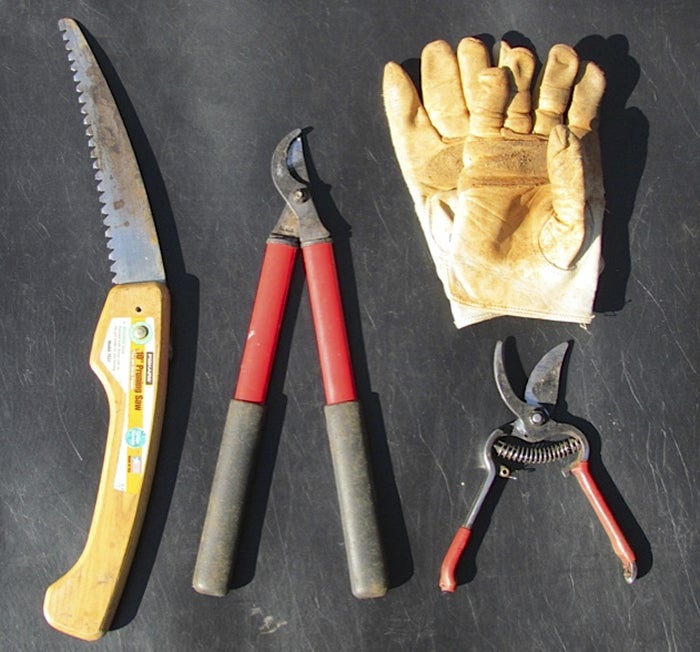Tips on pruning roses; Saturday offers experience
Published 12:00 am Friday, March 13, 2015

- Submitted photo What you need to start pruning, a hand saw, loppers, clippers and gloves.
By Carolyn Alexander
Extension Master Gardener Volunteer
Now is the time to start preparing for those beautiful rose blooms this summer. Pruning is one of the first chores of the year and is usually done in mid-March in this area.
Sometimes people are hesitant to cut their roses back because they are afraid they will damage them beyond repair. Roses are very forgiving. In the long run, it will not make a lot of difference if you cut too high or too low or to an inward facing bud instead of an outward facing one. You can always cut it again later to correct it.
Buy a good pair of by-pass or scissors type pruners and keep them sharp. Do not use anvil type pruners because they will damage the cane and allow diseases to enter the bush.
You will also need a small pruning saw for large canes and getting into places that cannot be reached with the pruners. Loppers are also useful for cutting larger canes and getting into the bushes without getting scratched.
Leather gloves are a must. Goatskin gloves are usually thorn resistant. Some rosarians use welder’s gloves. I like to use gauntlet gloves that cover my forearms almost to the elbows. Tougher clothing such as denim and long sleeves is also a good idea.
Start at the bottom of the bush. Remove soil and mulch from the bud union or base. If there are dead or sick-looking canes, cut them out. Remove them all the way to the bud union or base of the bush. Do not leave stubs.
On grafted roses, make sure all the growth is coming from above the bud union or graft. Canes coming from below the graft are suckers and will take over the bush if allowed to grow. Pull them off or dig them out. They tend to re-grow if cut off.
Decide how many canes you want to leave. Fewer canes will produce larger blooms. More canes will provide lots of blooms but they will be smaller. Remove canes that are crossing and rubbing against others. Prune out twiggy growth and very small canes.
Always cut to good healthy tissue, which can be recognized by the smooth green bark on the outside of the cane and white pith in the center of the cane.
Cuts should be made about 1/4 inch above an outside or outward facing bud-eye. This will be where the new growth comes from and you can control the growth of the bush by the place you make the cut. Cut at about a 45 degree angle away from the bud eye.
Different varieties of roses call for different pruning methods.
Hybrid Teas, Grandiflora, Floribundas, English roses: Remove all but five or six healthy canes. Cut out interior canes to promote good air circulation. Shorten the remaining canes to about 1/3 of their present height.
Shrubs: This includes the Knockout roses. Prune lightly to keep the plant in shape. Remove dead canes and open up the center of the plant if the growth is thick.
Miniatures: Remove all dead and twiggy growth and open up the center of the plant. Prune 8 to 15 inches above ground level.
Climbers: Repeat blooming climbers should be pruned while the plant is dormant. Shape the bush or reduce the size if it is too large. Prune the lateral branches coming from the main canes and leave three to five bud eyes on each. Climbers and ramblers that bloom only once should be pruned right after flowering is finished.
Old Garden roses: Roses that bloom only once should be pruned immediately after flowering. They do not like heavy pruning. Remove old, dead or unproductive wood and reduce the size by about a third. It is often helpful to remove several of the oldest canes each year to stimulate new growth.
After pruning, you should fertilize your roses and start your spray program to prevent diseases. Prevention is the key word. Once the rose has black spot or mildew, it cannot be reversed. The spread can be stopped by a consistent spray program but the diseased leaves will not revert back to their original condition.
The Rowan Rose Society will have a rose pruning clinic at the Triangle Rose Garden in front of Summersett Funeral Home on West Innes Street on Saturday from 8-10; rain date, March 21.
Robert Myers of the Perfect Rose will give a demonstration on the proper way to prune roses at 9 a.m. There will be consulting rosarians on hand to answer any rose questions. Bring heavy gloves and pruners and get some hands-on experience pruning these roses before you prune your own.
The Rose Society meets on the third Tuesday of February through June and September through November at 7 pm in the fellowship hall of John Calvin Presbyterian Church,1620 Brenner Ave. in Salisbury. Visitors are welcome.
Carolyn Alexander is a Cooperative Extension Volunteer Master Gardener and consulting rosarian for the American Rose Society.





